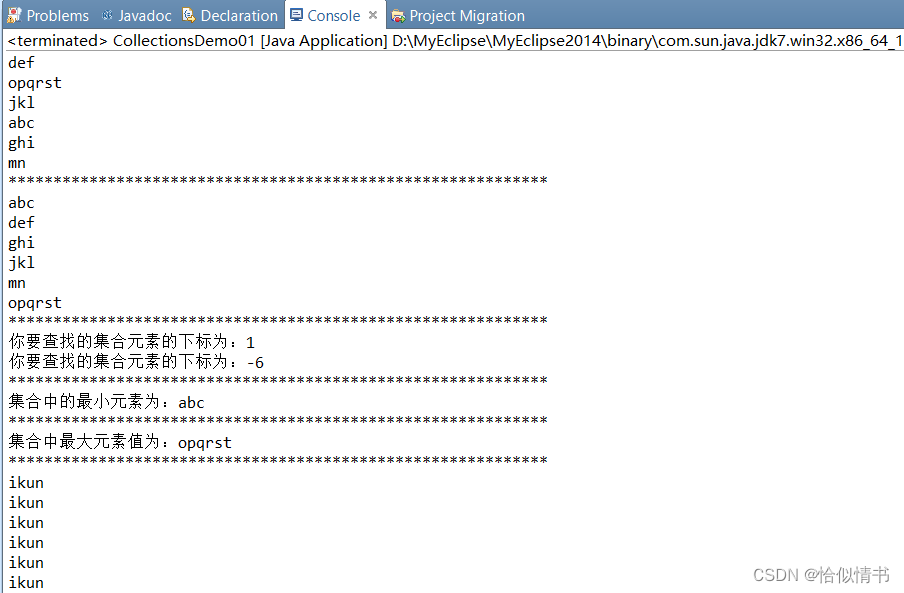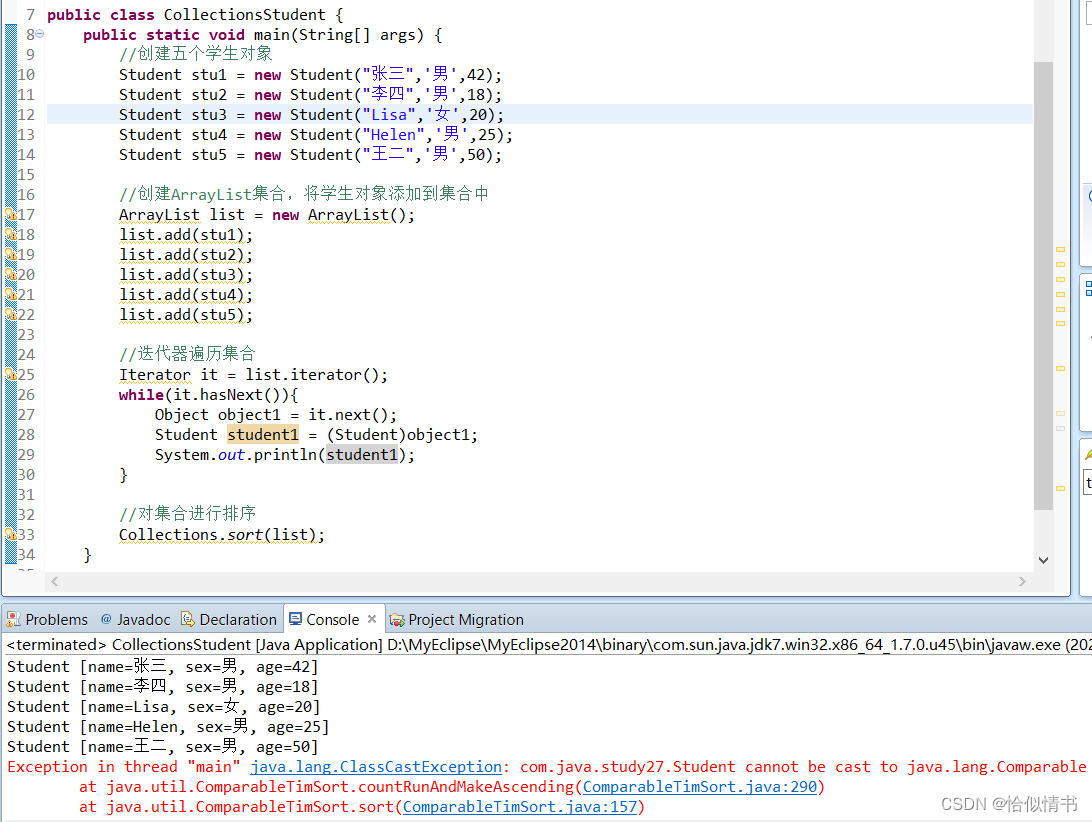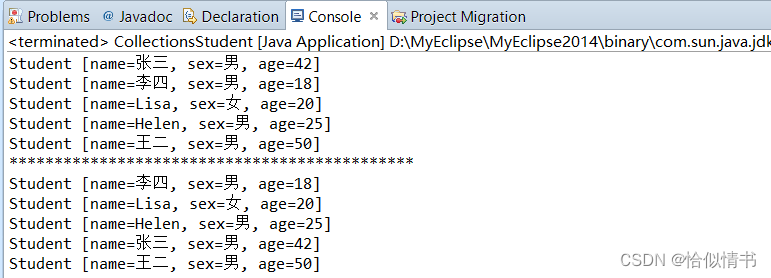目录
4.7 重写Comparable接口中的compareTo()方法
一、Java集合框架
Java集合框架提供了一套性能优良、使用方便的接口和类,它们都位于java.util包中;
Java集合类主要由Collection接口和Map接口派生而来,其中Collection接口有两个常用的子接口,即List接口和Set接口,所以通常说Java集合框架由三大类接口组成(List接口、Set接口、Map接口);
Collections类是包含在Collection上的多态算法。

二、Collections类
--->Java集合框架将针对不同数据结构算法的实现都保存在工具类中
--->Collections类定义了一系列用于操作集合的静态方法
--->Collections类完全由在 collection 上进行操作或返回 collection 的静态方法组成。它包含在 collection 上操作的多态算法,即“包装器”,包装器返回由指定 collection 支持的新 collection,以及少数其他内容。
--->Collections类是Java提供的一个集合操作工具类。它包含了大量的静态方法,用于实现对集合元素的排序、查找和替换等操作。
--->注意Collections和Collection的区别,Collections是操作类,Collection是集合接口
1、Collections类中的常用静态方法
静态方法可以通过类名直接调用。

--->使用binarySearch()方法可以查找集合中的元素,但是在使用binarySearch()方法之前需要使用sort()方法对集合进行排序,否则不能保证查找结果的正确性。 查找集合中不存在的元素,会返回一个负值
2、代码演示
import java.util.Collections;
import java.util.Iterator;
import java.util.LinkedList;
public class CollectionsDemo01 {
public static void main(String[] args) {
//创建个LinkedList集合
LinkedList list = new LinkedList();
//向集合中存入数据
list.add("def");
list.add("opqrst");
list.add("jkl");
list.add("abc");
list.add("ghi");
list.add("mn");
//遍历集合list
//迭代器遍历
Iterator it = list.iterator();
while(it.hasNext()){
Object object = it.next();
String cd = (String)object;
System.out.println(cd);
}
System.out.println("************************************************************");
//将集合中的额元素进行排序
Collections.sort(list);
//增强for循环遍历集合
for(Object object2:list){
String cd2 = (String)object2;
System.out.println(cd2);
}
System.out.println("************************************************************");
//查找集合中的元素
int index1 = Collections.binarySearch(list, "def");
System.out.println("你要查找的集合元素的下标为:"+index1);
int index2 = Collections.binarySearch(list, "ooo");
System.out.println("你要查找的集合元素的下标为:"+index2);
System.out.println("************************************************************");
//查找集合中的最小值
String minStr = Collections.min(list);
System.out.println("集合中的最小元素为:"+minStr);
System.out.println("************************************************************");
//查找集合中的最大元素值
String maxStr = Collections.max(list);
System.out.println("集合中最大元素值为:"+maxStr);
System.out.println("************************************************************");
//将集合中的所有元素替换为ikun
Collections.fill(list, "ikun");
//遍历集合
for(Object object3:list){
String str3 = (String)object3;
System.out.println(str3);
}
}
}
三、Comparable<T>接口
先看一个案例
创建Student类
public class Student {
private String name;
private char sex;
private int age;
//无参构造
public Student(){
}
//有参构造
public Student(String name, char sex, int age) {
super();
this.name = name;
this.sex = sex;
this.age = age;
}
//get/set方法
public String getName() {
return name;
}
public void setName(String name) {
this.name = name;
}
public char getSex() {
return sex;
}
public void setSex(char sex) {
this.sex = sex;
}
public int getAge() {
return age;
}
public void setAge(int age) {
this.age = age;
}
//toString方法
@Override
public String toString() {
return "Student [name=" + name + ", sex=" + sex + ", age=" + age + "]";
}
}创建测试类CollectionsStudent

这里报错了,代码是正确的,我们上面一个案例就没有报错。因为上一个案例,排序依据是字符串,而这个案例集合中存储的是对象,没有设置排序依据,我们可以通过Comparable接口中的方法设置排序依据。
1、Comparable<T>接口的作用
这个接口的能力就是进行自然排序
此接口强行对实现它的每个类的对象进行整体排序。这种排序被称为类的自然排序,类的 compareTo 方法被称为它的自然比较方法。
--->大部分类都实现了Comparable<T>接口。
2、compareTo方法
int compareTo():
比较此对象与指定对象的顺序。如果该对象小于、等于或大于指定对象,则分别返回负整数、零或正整数。
参数:
o- 要比较的对象。返回:
负整数、零或正整数,根据此对象是小于、等于还是大于指定对象。
3、重写compareTo方法
首先要实现Comparable接口,然后在重写CompareTo方法,排序的规则在重写的CompareTo方法体内编辑
public class Student implements Comparable<Student>{
private String name;
private char sex;
private int age;
//无参构造
public Student(){
}
//有参构造
public Student(String name, char sex, int age) {
super();
this.name = name;
this.sex = sex;
this.age = age;
}
//get/set方法
public String getName() {
return name;
}
public void setName(String name) {
this.name = name;
}
public char getSex() {
return sex;
}
public void setSex(char sex) {
this.sex = sex;
}
public int getAge() {
return age;
}
public void setAge(int age) {
this.age = age;
}
//toString方法
@Override
public String toString() {
return "Student [name=" + name + ", sex=" + sex + ", age=" + age + "]";
}
@Override
public int compareTo(Student stu) {
if(this.getAge()>stu.getAge()){
return 1;
}else if(this.getAge()==stu.getAge()){
return 0;
}else if(this.getAge()<stu.getAge()){
return -1;
}
return 0;
}
}import java.util.ArrayList;
import java.util.Collections;
import java.util.Iterator;
public class CollectionsStudent {
public static void main(String[] args) {
//创建五个学生对象
Student stu1 = new Student("张三",'男',42);
Student stu2 = new Student("李四",'男',18);
Student stu3 = new Student("Lisa",'女',20);
Student stu4 = new Student("Helen",'男',25);
Student stu5 = new Student("王二",'男',50);
//创建ArrayList集合,将学生对象添加到集合中
ArrayList list = new ArrayList();
list.add(stu1);
list.add(stu2);
list.add(stu3);
list.add(stu4);
list.add(stu5);
//迭代器遍历集合
Iterator it = list.iterator();
while(it.hasNext()){
Object object1 = it.next();
Student student1 = (Student)object1;
System.out.println(student1);
}
System.out.println("*********************************************");
//对集合进行排序
Collections.sort(list);
//遍历数组
for(Object object2:list){
Student student2 = (Student)object2;
System.out.println(student2);
}
}
}
四、泛型
泛型这个型是类型的型。
我们已经学习到这个地步,一般我们用集合来存储的集合元素是对象,而对象的类型是我们的属性类。所以本质上集合和数组一样,存储的都是同一类型的元素。
在不使用泛型时,集合中的元素会自动转型为Object类,我们在操作集合时,要进行繁琐的强制类型转换,而强制类型转换是非常容易发生类型转换异常的,为了解决这个问题,也为了我们少费点脑子,也为了减少我们脑细胞的死亡,就有了泛型这个东西,使用了泛型以后,就不需要强制类型转换了。
1、泛型的作用
(1)泛型是JDK1.5的新特性,泛型的本质是参数化类型,也就是说所操作的数据类型被指定为一个参数,使代码可以应用于多种类型。
(2)Java语言引入泛型的好处是安全简单,且所有强制转换都是自动和隐式进行的,提高了代码的重用率。
好处就是我们再也不用进行类型转换了,前面我们写的代码进行了很多次的类型转换,搞不好还出错,以后不会了,那些在集合代码中写强制类型转换的日子一去不复返了。至于为什么一开始不用泛型:因为要先了解各种集合,他们可以这么写,再说一次讲的太多会懵圈的,大家还是先把前面梳理顺畅了吧,不要像一口吃个大胖子,会找不到对象的。,要一顿饭一顿饭的吃,消化完再吃
2、泛型的定义
(1)将对象的类型作为参数,指定到其他类或者方法上,从而保证类型转换的安全性和稳定性。这就是泛型。泛型的本质就是参数化类型。
(2)语法格式:
类1或者接口<类型实参> 对象 = new 类2<类型实参>();
--->“类2”可以是“类1”本身,可以是“类1”的子类,还可以是接口的实现类;
--->“类2”的类型实参必须和“类1”中的类型实参相同.
例如:我们前面常用的Student类:
ArrayList<Student> list = new ArrayList<Student>();
创建一个ArrayList类的集合,集合中存储的元素必须是Student类。

定义了泛型以后,集合就只能存储泛型规定的类
3、泛型在集合中的应用
(1)List和ArrayList的泛型形式是List<E>和ArrayList<E>,ArrayList<E>与ArrayList类的常用方法基本一样;
(2)Map与HashMap也有它们的泛型形式,即Map<K,V>和HashMap<K,V>,因为它们的每一个元素都包含两个部分,及key和value,所以,在应用泛型时,要同时指定key的类型和value的类型,K表示key的类型,V表示value的类型。HashMap<K,V>操作数据的方法与HashMap基本一样;
(3)泛型使集合的使用更方便,也提升了安全:
--->存储数据时进行严格类型检查,确保只有合适类型的对象才能存储在集合中。
--->从集合中检索对象时,减少了强制类型转换。
主要是会用就行,定义啥的把一些简单明了的话变成了一堆谁也看不懂的文字,大家只要能仿照我下面的代码,会用泛型就行。
4、代码修改
带有强制类型转换的代码都可以修改
4.1 属性类
public class Student implements Comparable<Student>{
private String name;
private char sex;
private int age;
//无参构造
public Student(){
}
//有参构造
public Student(String name, char sex, int age) {
super();
this.name = name;
this.sex = sex;
this.age = age;
}
//get/set方法
public String getName() {
return name;
}
public void setName(String name) {
this.name = name;
}
public char getSex() {
return sex;
}
public void setSex(char sex) {
this.sex = sex;
}
public int getAge() {
return age;
}
public void setAge(int age) {
this.age = age;
}
//toString方法
@Override
public String toString() {
return "Student [name=" + name + ", sex=" + sex + ", age=" + age + "]";
}
@Override
public int compareTo(Student stu) {
if(this.getAge()>stu.getAge()){
return 1;
}else if(this.getAge()==stu.getAge()){
return 0;
}else if(this.getAge()<stu.getAge()){
return -1;
}
return 0;
}
}4.2 ArrayList集合
import java.util.ArrayList;
import java.util.Iterator;
public class ArraysListDemo01 {
public static void main(String[] args) {
//创建两个NewsTitle类对象
NewsTitle nt01 = new NewsTitle(1001,"我的很大吴亦凡!","张三");
NewsTitle nt02 = new NewsTitle(1002,"一次六千李云迪!","李四");
//使用ArrayList类创建一个集合容器
ArrayList<NewsTitle> al = new ArrayList<NewsTitle>();
//使用ArrayList类中的add()方法,将数据存入到集合中
al.add(nt01);
al.add(nt02);
al.add(nt01);//ArraysList是一个有序的不唯一的集合(里面的元素可以重复)
System.out.println(al);
System.out.println("*****************************************************************************");
//将集合存储到集合中的指定位置add(int index,Object object)
NewsTitle nt03 = new NewsTitle(1003,"死不承认李易峰!","王二");
al.add(1, nt03);
al.add(nt03);
System.out.println(al);
System.out.println("*****************************************************************************");
//通过集合对象名al调用方法,对集合元素进行操作
//获取元素个数
int size = al.size();
System.out.println("集合al的元素个数为:"+size+"个。");
System.out.println("*****************************************************************************");
//获取集合中指定下标的元素
//获取下标为0的集合元素
NewsTitle object01 = al.get(0);
System.out.println(object01);//当你直接输出对象名的时候输出的是地址值,重写了toString方法,输出的是toString方法的内容
System.out.println("*****************************************************************************");
//遍历集合中的元素
for(int i = 0;i < al.size();i++){
NewsTitle forNt = al.get(i);
System.out.println(forNt);
}
System.out.println("*****************************************************************************");
//判断集合中是否包含某个元素
boolean result = al.contains(nt02);
System.out.println("集合中是否包含nt02这个元素?"+result);
System.out.println("*****************************************************************************");
//删除集合中的元素:ramove(元素名)/remove(元素下标)
boolean result01 = al.remove(nt02);
System.out.println("元素nt02是否删除成功:"+result01);
NewsTitle result02 = al.remove(0);
System.out.println("删除的元素:"+result02);
System.out.println("删除后的集合:"+al);
System.out.println("*****************************************************************************");
//普通for循环遍历集合
for(int i = 0;i < al.size();i++){
NewsTitle object = al.get(i);
System.out.println(object);
}
System.out.println("*****************************************************************************");
//使用增强for循环遍历数组
//没有使用泛型的时候,集合里面所有的元素都会向上转型为Object类
for(NewsTitle object:al){
System.out.println(object);
}
System.out.println("*****************************************************************************");
//删除元素后使用迭代器遍历集合:iterator()
Iterator<NewsTitle> it = al.iterator();
//从it容器中取出元素
while(it.hasNext()){
NewsTitle newst = it.next();
System.out.println(newst);
}
System.out.println("*****************************************************************************");
//判断集合是否为空:isEmpty
boolean result00 = al.isEmpty();
System.out.println("集合al是否为空:"+result00);
System.out.println("*****************************************************************************");
//将集合转换为数组:toArray
Object[] objec = al.toArray();
//遍历数组
for(int i = 0;i < objec.length;i++){
System.out.println(objec[i]);
}
System.out.println("*****************************************************************************");
System.out.println("集合的方法还能用:"+al.get(0));
System.out.println("*****************************************************************************");
//清空集合:clear()
al.clear();
System.out.println(al.size());
System.out.println("集合是否为空:"+al.isEmpty());
}
}4.3 LinkedList集合
import java.util.LinkedList;
import java.util.List;
public class LinkedListDemo01 {
public static void main(String[] args) {
//创建三个NewsTitle类对象
NewsTitle nt01 = new NewsTitle(1001,"我的很大吴亦凡!","张三");
NewsTitle nt02 = new NewsTitle(1002,"一次六千李云迪!","李四");
NewsTitle nt03 = new NewsTitle(1003,"死不承认李易峰!","王二");
//创建集合容器
List<NewsTitle> list = new LinkedList<NewsTitle>();
//添加数据
list.add(nt01);
list.add(nt02);
list.add(nt03);
//将nt03存储到集合第一个位置
//接口的引用,无法使用实现类中特有的方法,需要向下转型
//list.addFirst(nt03);
LinkedList<NewsTitle> linkedList = (LinkedList<NewsTitle>)list;
linkedList.addFirst(nt03);
//将nt01添加到集合尾部
linkedList.addLast(nt01);
//遍历集合
for(NewsTitle nt:list){
//类型转换
System.out.println(nt);
}
System.out.println("*******************************************************************");
//返回列表中的第一个元素和最后一个元素
NewsTitle news01 = linkedList.getFirst();
System.out.println("返回首个元素:"+news01);
NewsTitle news02 = linkedList.getLast();
System.out.println("返回末尾元素:"+news02);
System.out.println("*******************************************************************");
//删除并返回集合中的第一个元素和最后一个元素:removeFirst()/removeLast()
NewsTitle obj03 = linkedList.removeFirst();
System.out.println("删除并返回集合中的第一个元素:"+obj03);
System.out.println("删除并返回集合中的最后一个元素:"+linkedList.removeLast());
System.out.println("*******************************************************************");
for(int i = 0;i < list.size();i++){
NewsTitle newst = list.get(i);
System.out.println(newst);
}
}
}
4.4 HashSet集合
import java.util.HashSet;
import java.util.Iterator;
public class HashSetDemo01 {
public static void main(String[] args) {
//创建三个NewsTitle类对象
NewsTitle nt01 = new NewsTitle(1001,"我的很大吴亦凡!","张三");
NewsTitle nt02 = new NewsTitle(1002,"一次六千李云迪!","李四");
NewsTitle nt03 = new NewsTitle(1003,"死不承认李易峰!","王二");
//创建集合容器
HashSet<NewsTitle> hs = new HashSet<NewsTitle>();
//添加数据:add()
hs.add(nt01);
hs.add(nt02);
hs.add(nt03);
//集合中元素个数:size()
int size = hs.size();
System.out.println("Set集合中元素的数量为:"+size);
System.out.println("***************************************************************");
//增强for循环遍历数组
for(NewsTitle newsTitle:hs){
System.out.println(newsTitle);
}
System.out.println("***************************************************************");
//迭代器遍历数组
//将集合元素取出来放到迭代器容器中
Iterator<NewsTitle> it = hs.iterator();
//使用hashNext()方法判断迭代器是否有元素
while(it.hasNext()){
//使用next()方法取出元素
NewsTitle nt = it.next();
System.out.println(nt);
}
}
}
4.5 HashMap集合
public class Student implements Comparable<Student>{
private String name;
private char sex;
private int age;
//无参构造
public Student(){
}
//有参构造
public Student(String name, char sex, int age) {
super();
this.name = name;
this.sex = sex;
this.age = age;
}
//get/set方法
public String getName() {
return name;
}
public void setName(String name) {
this.name = name;
}
public char getSex() {
return sex;
}
public void setSex(char sex) {
this.sex = sex;
}
public int getAge() {
return age;
}
public void setAge(int age) {
this.age = age;
}
//toString方法
@Override
public String toString() {
return "Student [name=" + name + ", sex=" + sex + ", age=" + age + "]";
}
@Override
public int compareTo(Student stu) {
if(this.getAge()>stu.getAge()){
return 1;
}else if(this.getAge()==stu.getAge()){
return 0;
}else if(this.getAge()<stu.getAge()){
return -1;
}
return 0;
}
}
import java.util.Collection;
import java.util.HashMap;
import java.util.Iterator;
import java.util.Map;
import java.util.Map.Entry;
import java.util.Set;
public class HashMapDemo01 {
public static void main(String[] args) {
//准备三个Student类对象
Student stu01 = new Student("张三",'男',20);
Student stu02 = new Student("李四",'男',30);
Student stu03 = new Student("Lisa",'女',18);
//创建Map集合容器(多态)
Map<String,Student> map = new HashMap<String,Student>();
//添加元素
map.put("zs", stu01);
map.put("ls", stu02);
map.put("lisa", stu03);
//获取集合中的元素个数
int size = map.size();
System.out.println("Map集合长度:"+size);
System.out.println("***********************************************************");
//根据键(key)获取键对应的值:get(Object key)
Student student01 = map.get("zs");
System.out.println(student01);
System.out.println("***********************************************************");
//根据键删除键值对
Student student02 = map.remove("ls");
System.out.println("你删除的元素为:"+student02);
System.out.println("Map集合长度:"+map.size());
System.out.println("***********************************************************");
//判断集合中是否包含键:containsKey(Object key)
boolean result01 = map.containsKey("zs");
System.out.println("集合中包含键“zs”?"+result01);
System.out.println("集合中包含键“mz”?"+map.containsKey("mz"));
//判断集合中是否包含值:containsValue(Object value)
System.out.println("集合中包含值stu01?"+map.containsValue(stu01));
System.out.println("***********************************************************");
//获取集合中的所有键:keySet()
Set<String> keys = map.keySet();
for(String key:keys){
//我们设置的键是String类型
System.out.println(key);
}
System.out.println("***********************************************************");
//获取集合中的所有值:values()
Collection<Student> value = map.values();
Iterator<Student> it = value.iterator();
while(it.hasNext()){
Student stud = it.next();
System.out.println(stud);
}
System.out.println("***********************************************************");
//通过键遍历Map集合
//通过键的集合,然后通过键来找值
Set<String> keyset = map.keySet();
//增强for循环
for(String strKey:keyset){
Student student1 = map.get(strKey);
System.out.println(strKey+"对应的学生:"+student1);
}
System.out.println("***********************************************************");
//迭代器遍历
Iterator<String> it01 = keyset.iterator();
while(it01.hasNext()){
String strkey = it01.next();
Student student2 = map.get(strkey);
System.out.println(strkey+"对应的学生:"+student2);
}
System.out.println("***********************************************************");
//Map.Entry接口遍历集合
Set<Entry<String, Student>> keyValues = map.entrySet();
for(Map.Entry<String,Student> me:keyValues){
//获取键
String stringkey = me.getKey();
//获取值
Student student3 = me.getValue();
System.out.println(stringkey+"对应的学生:"+student3);
}
}
}4.6 Collections类的方法
import java.util.Collections;
import java.util.Iterator;
import java.util.LinkedList;
public class CollectionsDemo01 {
public static void main(String[] args) {
//创建个LinkedList集合
LinkedList<String> list = new LinkedList<String>();
//向集合中存入数据
list.add("def");
list.add("opqrst");
list.add("jkl");
list.add("abc");
list.add("ghi");
list.add("mn");
//遍历集合list
//迭代器遍历
Iterator<String> it = list.iterator();
while(it.hasNext()){
String cd = it.next();
System.out.println(cd);
}
System.out.println("************************************************************");
//将集合中的元素进行排序
Collections.sort(list);
//增强for循环遍历集合
for(String cd2:list){
System.out.println(cd2);
}
System.out.println("************************************************************");
//查找集合中的元素
int index1 = Collections.binarySearch(list, "def");
System.out.println("你要查找的集合元素的下标为:"+index1);
int index2 = Collections.binarySearch(list, "ooo");
System.out.println("你要查找的集合元素的下标为:"+index2);
System.out.println("************************************************************");
//查找集合中的最小值
String minStr = Collections.min(list);
System.out.println("集合中的最小元素为:"+minStr);
System.out.println("************************************************************");
//查找集合中的最大元素值
String maxStr = Collections.max(list);
System.out.println("集合中最大元素值为:"+maxStr);
System.out.println("************************************************************");
//将集合中的所有元素替换为ikun
Collections.fill(list, "ikun");
//遍历集合
for(String str3:list){
System.out.println(str3);
}
}
}4.7 重写Comparable<T>接口中的compareTo()方法
import java.util.ArrayList;
import java.util.Collections;
import java.util.Iterator;
public class CollectionsStudent {
public static void main(String[] args) {
//创建五个学生对象
Student stu1 = new Student("张三",'男',42);
Student stu2 = new Student("李四",'男',18);
Student stu3 = new Student("Lisa",'女',20);
Student stu4 = new Student("Helen",'男',25);
Student stu5 = new Student("王二",'男',50);
//创建ArrayList集合,将学生对象添加到集合中
ArrayList<Student> list = new ArrayList<Student>();
list.add(stu1);
list.add(stu2);
list.add(stu3);
list.add(stu4);
list.add(stu5);
//迭代器遍历集合
Iterator<Student> it = list.iterator();
while(it.hasNext()){
Student student1 = it.next();
System.out.println(student1);
}
System.out.println("*********************************************");
//对集合进行排序
Collections.sort(list);
//遍历数组
for(Student student2:list){
System.out.println(student2);
}
}
}
5、深入泛型
随便了解一下就行
(1)在集合中使用泛型只是泛型多种应用的一种,在接口、类、方法等方面也有着泛型的广泛应用。
(2)定义泛型接口或类的过程,与定义一个接口或者类相似。
5.1 定义泛型类
概念:泛型类简单地说就是具有一个或者多个类型参数的类。
语法:
访问修饰符 class 类名<TypeList>--->TypeList表示类型参数列表,每个类型变量之间以逗号分隔。
5.2 定义泛型接口
概念:泛型接口就是拥有一个或者多个类型参数的接口。泛型接口的定义方式与定义泛型类类似。
语法格式:
访问修饰符 interface 接口名<TypeList>
泛型类实现泛型接口:
访问修饰符 class 类名<TypeList> implements 接口名<TypeList>
5.3 定义泛型方法
概述:一些方法常常需要对某一类型数据进行处理,若处理的数据乐行不确定,则可以通过泛型方法的方式来定义,达到简化代码、提高代码重用性的目的。
泛型方法实际上就是带有类型参数的方法。
定义泛型方法与方法所在的类、或者接口是否是泛型类或者泛型接口没有直接的关系,也就是说无论是泛型类还是非泛型类,如果需要就可以定义泛型方法。
语法格式:
访问修饰符 <类型参数> 返回值 方法名(类型参数列表)
--->TypeList表示由逗号分隔的一个或多个类型参数列表。
类型变量放置在访问修饰符与返回值之间
5.4 多个参数的泛型类
(1)泛型类的类型参数可以有一个或者多个。
(2) 比如HashMap<K,V>就有两个类型参数,一个指定key的类型,一个指定value的类型。
5.5 从泛型类派生子类
(1)面向对象的特征同样适用于泛型类,所以泛型类也可以继承。
(2)继承了反省类的子类,必须也是泛型类。
(3)继承泛型类的语法格式:class 子类<T> extends 父类<T>{}
五、集合框架和泛型总结
1、集合弥补了数组的缺陷,它比数组更灵活实用,而且不同的集合适用于不同场合;
2、Java集合框架共有3大类接口,即Map接口、List接口和Set接口;
3、List集合可以存储一组重复的元素;Set集合中的额元素不能重复;Map集合存储的是一组兼职对象的元素,键不可以重复,值可以重复;
4、ArrayList和数组采用相同的存储方式,它的特点是长度可变且可以存储任何类型的数据,它的优点在于遍历元素和随机访问元素的效率较高;
5、LinkedList类采用链表存储方式,优点在于插入、删除元素时效率较高;
6、Iterator为集合而生,专门实现集合的遍历,它隐藏了各种集合实现类的内部细节,提供了遍历集合的统一编程接口;
7、 HashMap类是最常用的Map实现类,它的特点是存储键值对数据,优点是查询指定元素效率高;
8、泛型的本质是参数化类型,也就是说所操作的数据类型被指定为一个参数,使代码可以应用于多种数据类型;
9、使用泛型集合在创建集合对象时指定集合中元素的类型,从集合中取出元素时无需进行强制类型转换;
10、在集合中使用泛型只是泛型多种应用的一种,在接口、类、方法等方面也有着泛型的广泛应用;
11、如果数据类型不确定,可以通过泛型方法的方式,达到简化代码、提高代码重用性的目的
这篇博文竟然都快达到两万字了,不过学习的内容并不多,定义和代码一大堆,没必要去背定义,知道怎么用就行了; 代码都是以前学过的,大部分都是重复的,把以前的代码拿过来使用泛型;不过大家不要偷懒,不要在原有的代码上修改,重新建个包,哪怕复制粘贴也行,万一哪天想不起来了还能看看。今天的学习到此结束,我是一米八、有腹肌、低于半小时你报警的Loveletter,觉得内容不错的小伙伴可以点点关注,我们下篇博文见,再见!
























 3869
3869











 被折叠的 条评论
为什么被折叠?
被折叠的 条评论
为什么被折叠?








